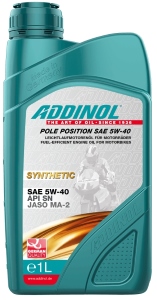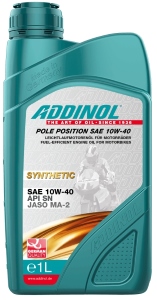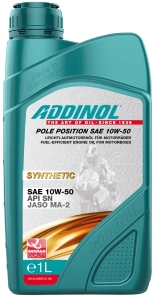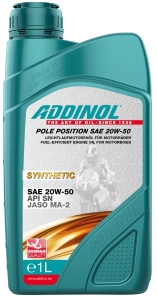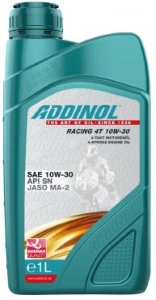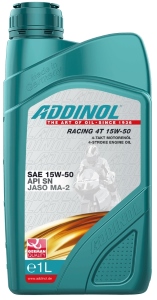


4-stroke oils for motorcycles
4-stroke oils are used in 4-stroke engines. These are mainly used in motorcycles, but also in scooters, mopeds or lawnmowers. In four-stroke engines, moving parts such as pistons and crankshafts are lubricated via an independent oil supply. In many cases, the oil circuit also supplies the transmission or the transmission is integrated in the engine compartment. Which oil is suitable for your motorcycle, scooter or moped is entirely up to the OEM instructions. With our Oilfinder you can check which 4-stroke oil is approved for your machine. It is important to comply with the correct SAE class (viscosity) and API or JASO specifications.
Our 4-stroke oils
ADDINOL POLE POSITION SAE 5W-40
Specifications / Approvals:
API SN
JASO MA, JASO MA-2
ADDINOL POLE POSITION SAE 10W-40
Specifications / Approvals:
API SN
JASO MA, JASO MA-2
ADDINOL SUPER RACING 5W-50
Specifications / Approvals:
API SN
JASO MA, JASO MA-2
ADDINOL POLE POSITION SAE 10W-50
Specifications / Approvals:
API SN
JASO MA, JASO MA-2
ADDINOL POLE POSITION SAE 20W-50
Specifications / Approvals:
API SN
JASO MA, JASO MA-2
ADDINOL SUPER RACING 10W-60
Specifications / Approvals:
API SN
JASO MA, JASO MA-2
ADDINOL RACING 4T 10W-30
Specifications / Approvals:
API SP
JASO MA-2
ADDINOL RACING 4T 15W-50
Specifications / Approvals:
API SP
JASO MA-2
Engine oil for motorcycles
The engine oil of motorcycles must meet different requirements than those of passenger cars. Motorcycles run at higher rpm and higher temperatures than cars. The engines are usually cooled with air and not with water. In addition to the engine, the oil also supplies the transmission and clutch in one circuit. Due to the transmission, the oil is exposed to a higher shearing force than in a passenger car. Engine oils for motorcycles therefore require special additive mixtures in order to withstand the load. High-pressure additives (EP additives) provide a remedy in this case. In addition, motorcycles with oil bath clutches do not tolerate additives to reduce the coefficient of friction as they are present in low-viscosity oils. This increases the risk of the clutch slipping. Therefore, pay attention to the OEM approvals before buying oil.

4-stroke oil classifications
All motorcycle oils from ADDINOL are characterized by the following properties:
- High thermal load capacity
- Very good cleaning properties
- Very good corrosion and wear protection properties
- Smooth-running character even after cold start
- Fuel savings combined with higher performance
- Suitable for all motorcycles with air- and water-cooled 4-stroke engines
- Safe function of wet couplings even under extreme conditions
The more exact classification of the 4-stroke oils is made by the classification by SAE specifications, API specifications and JASO specifications. We summarize the most important specifications for you so that you can keep an overview.
SAE specifications for motorcycles
The SAE classes are defined by the Society of Automotive Engineers. They refer to the viscosity of engine oils at different operating temperatures. Today, multigrade oils are common, because they can be used in a wide temperature range and produce a constantly stable lubricating film.
Common SAE classes for 4-stroke oils are:
The number before the W describes the winter suitability of the oil. The smaller the number, the colder the temperatures the oil is up to. The number after W describes the viscosity of the oil at 100 °C. The higher the value, the more powerful the engine oil is.
Motorcycle engines generally do not use low-viscosity oils such as 0W30, as the high shear loads in the transmission would put too much strain on the oil.
API Specification for motorcycles
The API specifications define minimum requirements for engine oils. They are published by the American Petroleum Institute. For 4-stroke engines, the classifications of the S series, which apply exclusively to petrol engines, are decisive. The classes range from SA to SN, with the higher letter reflecting increased demands on the oil. Since 2011, the API-SN approval class has been an important quality feature for engine oils.
| API class | Description |
| API SN |
|
JASO specifications for motorcycle oils
The Japanese Automotive Standards Organisation defines special classes for 4-stroke engines. The JASO specifications are more precise in their requirements for use in motorcycles with oil bath clutches. For example, some low-friction oils for passenger cars have a too low coefficient of friction, which can cause the clutch to slip on motorcycles. Since the API does not require a minimum specification for the friction coefficient of an oil, JASO has included it accordingly.
| JASO class | Description |
| JASO MA 1 | Suitable for oil bath clutches |
| JASO MA 2 | Suitable for oil bath couplings, but higher standard than MA1 |
| JASO MB | Not suitable for oil bath clutches, for motorcycles with dry clutch or separately lubricated transmission. |
Difference between 2-stroke and 4-stroke oil
The difference between 2-stroke oil and 4-stroke oil lies in the different construction and function of the engines. With 2-strokes, the engine oil is usually added directly to the fuel. 2-stroke oil must therefore mix well with petrol or diesel. This ensures that the moving parts in the engine compartment are adequately lubricated. The oil is consumed with the fuel and must be burned as residue-free as possible.
With a 4-stroke, there is no mixing between fuel and engine oil. The 4-stroke engine oil is filled into a separate oil circuit. The oil bath then supplies the piston and crankshaft with sufficient lubrication. In some cases, the transmission is also lubricated via this oil circuit. We have summarized the most important differences again in tabular form.
| Oil type | Features & benefits |
| 2-stroke oil |
|
| 4-stroke oil |
|
Due to these different properties of 2-stroke and 4-stroke oils, a mixture of both oils is not recommended. Also, no 4-stroke oil should be filled into 2-stroke engines and vice versa. Engine damage will inevitably occur if the wrong oil is used. 4-stroke oil will burn not clean in the 2-stroke engine and leave residues in the exhaust system and engine which will clog the engine. The 2-stroke oil does not have the required pressure resistance for a 4-stroke engine. The lubricating film will tear off, resulting in inadequate lubrication and increased wear.
How often should the motorcycle oil be changed?
Due to the high speeds and operating temperatures in the engine, the lubricant wears off and ages. The oil must therefore be changed regularly. Usually there is an annual change or an exchange every 6,000-10,000 kilometres. The exact oil change intervals for your motorcycle can be found in the OEM instructions for your machine. These specifications vary from model to model.


